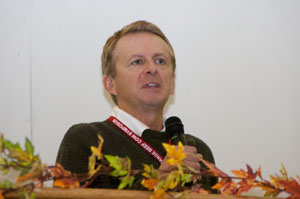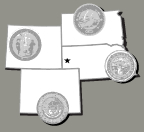Planning Ahead for Forage Shortage Due to Drought
by Kasey Miller for Angus Productions Inc.
MITCHELL, Neb. (Dec. 1, 2011) — “In the last 10 to 15 years, the vast majority of cattle producers have been impacted by drought. It’s an issue we can’t ignore; it won’t go away,” said Jerry Volesky, range and forage specialist from the University of Nebraska–Lincoln (UNL), as he spoke to attendees of the 22nd Range Beef Cow Symposium in Mitchell, Neb., Dec. 1.

Jerry VoleskyHe emphasized that while producers in the Great Plains are experiencing an extreme drought now, they are not the only area affected, and it is prudent to plan ahead no matter the location. By definition, a drought is when rainfall is 75% below average.
There are several significant implications to agriculture, he added, including increasing carbon dioxide and gases, increasing average temperatures, Central and Northern Plains are experiencing warmer low temperatures and a longer growing season, long-term average precipitation may be similar, and greater frequency of extreme weather events such as excessive rainfall and drought.
To combat these weather changes, he urged producers to plan ahead. He said, “Producers with a drought plan actively monitor resources; build ecological, financial and social resilience in their operations; and are proactive during drought in order to minimize short- and long-term damanges.”
Cattlemen should know the forage production from their pastures. Volesky said that there is much variability in herbage production, but a good indicator is the amount of rainfall in May, June and July — that rainfall is critical for forage production. Knowing the relationship between rain amounts and timing, ranchers can plan for herbage production before the end of the growing season and adjust stocking rates as needed. Additionally, Volesky mentioned that in a drought, plants reach maturity much earlier in the season, which is directly related to their nutritional value.
He offered some strategies to offset the drought impact, which in addition to finding other forage, included reducing animal numbers and weaning early. By weaning early, the cow’s nutrient requirements decrease, and it’s estimated that 10 pounds (lb.) of forage are conserved per day that the calf is weaned.
Wet distiller’s grains mixed with low quality forage and fed to cow-calf pairs while grazing summer pasture will reduce grazed forage intake. He also recommended using seeded annual or perennial, both for warm- and cool-season grasses. Obviously, irrigation can help, too, and he said a little goes a long way.
He estimated that 800-1000 lbs. of hay was heading south daily since July. If ranchers decide to buy hay, he urged them to forage test, because “you’re not sure what you’re getting.”
For more drought management resources, he recommended the “Managing Drought Risk on the Ranch” website designed by UNL National Drought Mitigation Center (NDMC). The website was developed with input from ranchers and advisors. It can help with steps to develop a plan, development of resource inventories, decision-support tools for grazing and livestock management, evaluation dourght response options and financial decision-support tools.
To see the PowerPoint that accompanied Volesky's presentation, click here. For more information, visit drought.unl.edu/ranchplan.
The biennial Range Beef Cow Symposium was hosted Nov. 29-Dec. 1 at the Mitchell Events Center, Mitchell, Neb., by the cooperative extension and animal science departments of the University of Nebraska-Lincoln, South Dakota State University, Colorado State University and the University of Wyoming. Comprehensive coverage of the event is provided online at www.rangebeefcow.com, an event coverage site provided by Angus Productions Inc. (API), publisher of the Angus Journal and the Angus Beef Bulletin.
Editor’s Note: API's coverage of the event is made available for distribution to all media via an agreement with the Range Beef Cow Symposium Committee and API. Headquartered in Saint Joseph, Mo., API publishes the Angus Journal, the Angus Beef Bulletin, the Angus Beef Bulletin EXTRA, and the Angus e-List, as well as providing online coverage of events and topics pertinent to cattlemen through the API Virtual Library. For questions about this site, or to notifiy us of broken links, click here.

